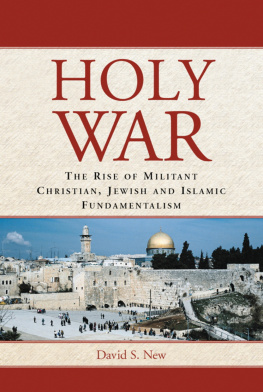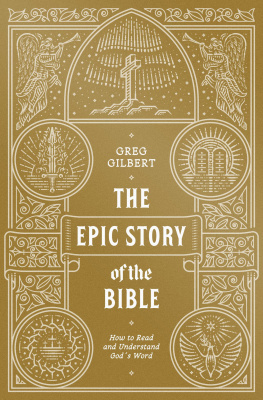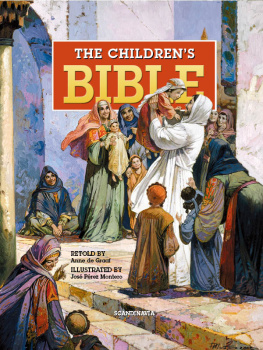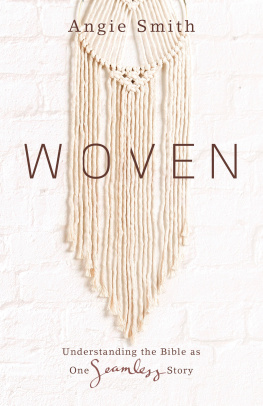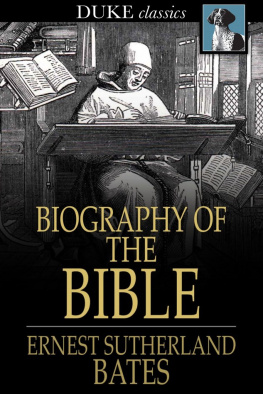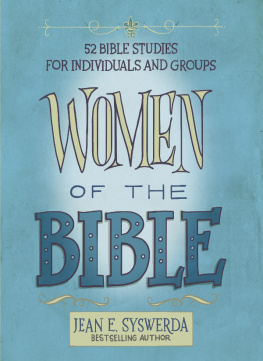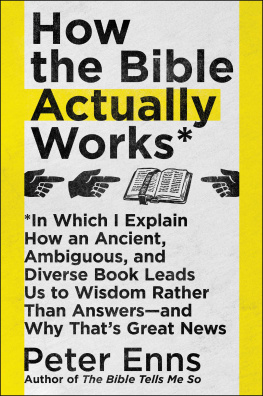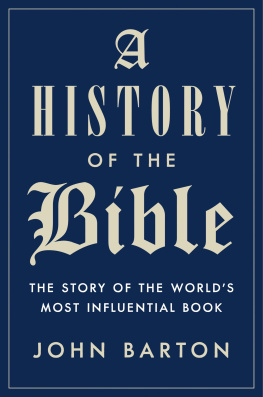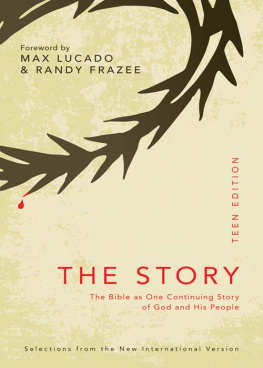
Also by DAVID S. NEW
Christian Fundamentalism in America: A Cultural History (McFarland, 2012)
Holy War: The Rise of Militant Christian, Jewish and Islamic Fundamentalism (McFarland, 2002)
The Text of the Bible
Its Path Through History and to the People
DAVID S. NEW

McFarland & Company, Inc., Publishers
Jefferson, North Carolina, and London
LIBRARY OF CONGRESS CATALOGUING DATA ARE AVAILABLE
BRITISH LIBRARY CATALOGUING DATA ARE AVAILABLE
e-ISBN: 978-1-4766-0270-7
2013 David S. New. All rights reserved
No part of this book may be reproduced or transmitted in any form or by any means, electronic or mechanical, including photocopying or recording, or by any information storage and retrieval system, without permission in writing from the publisher.
On the cover: scribe at desk 2012 Clipart.com
McFarland & Company, Inc., Publishers
Box 611, Jefferson, North Carolina 28640
www.mcfarlandpub.com
Preface
Outside the windows of the air-conditioned tourist bus scorching heat shimmers off rock cliffs in a natural oven which reaches brutal temperatures. In this seemingly God-forsaken wasteland the brassy sun shows no mercy for any living thing. I strain to peer through the haze and catch a glimpse of the sea, languid under humid mist.
This is the land of the damned. The story is from the biblical book of Genesis, our guide Angie informs us. Abraham pleaded with his god Yahweh to not destroy Sodom and Gomorrah. Yahweh agreed, provided there were ten righteous people among the wicked in these cities. There were not. Yahwehs anger raged; down rained a sulphurous re. All plant life was destroyed; the valley became a furnace. Just before this destruction, angels from Yahweh had warned a man named Lot that he and his family should ee for their lives into the hills. They must not look back or stop anywhere in the valley. But, Angie smiles, we all know that women can be curious. There is conspiratorial but cautious laughter from the men on the tour. Angie continues. So it was with Lots wife. She could not resist a look back. She had to see what she was forbidden to see. So she looked back, and was turned into a pillar of salt. If you look out the windows you will see pillars of salt, although we dont know which one is Lots wife. Yahwehs curse upon the land was for eternity. Nothing changes here. Everything speaks of death. The Dead Sea.
The forbidding scene outside the windows of the bus causes a bead of sweat to trickle down my brow. Thank God for air conditioning! When do we stop for refreshments? someone in the rear of the bus asks. No sooner are these words spoken than the bus turns onto a gentle incline, away from the sea. We pull into a parking lot and lurch to a halt. Another group of tourists is getting back onto their bus; they look relaxed and refreshed. The door of the bus opens and the breath is sucked from my lungs. Not even a hint of breeze. Its absolutely stiing. The sunlight is blinding. And that sulphurous smell! My legs cant get me into the snack bar fast enough.
Soon our thirsts are quenched, our lungs lled with cooler air. Our bodies have resumed some degree of normal equilibrium. Is everyone nished? Angie asks. There are reluctant sighs; no one is in a hurry to leave this oasis of comfort. Okay ... okay, Angie beams her understanding smile, seeing as no other tour bus has arrived, Ill give you a break and start my spiel inside. This garners a hearty round of afrming applause.
Just a few feet from the snack barfortunately it isnt going to be a long walk in the heatis what appears to be a labyrinth fashioned from stones of every size and shape. Angie tells us that back in Jesuss time the walls that stood on these foundations formed the habitation for a group of monks. Signs in Hebrew and English point to the location of what had once been a dining hall, what had once been a kitchen. She points out the scriptorium, where scribes copied manuscripts onto leather scrolls. The nished scrolls were deposited in nearby caves. For this is where the famous Dead Sea Scrolls originated, Angie informs us.
One of our group says she had read that this is just a theory, that scholars disagree: some say it was inhabited by monks, but others think it may have been a fortress. Angie nods acknowledgment. Thats scholars for you! Never can agree on anything. People laugh and look in my direction. I raise my hands in supplication as if to say, What can you do?, and smile.
Angie resumes. For now, well stick with the conventional opinion, that this establishment was inhabited by a group of Jews who had separated from other Jews, and who had their own beliefs and religious practices. They werent here for long before the Romans came and put an end to their desert existence.
Reluctantly we follow Angies lead outside, into the sweltering heat. We havent examined the remains of the ancient foundations for more than a few minutes when an older woman expresses her disappointed wishes for the tour: When are we going to visit some place where its not so hot and barren? You know, like those illustrations you see in the Biblethe cool green places where Jesus spoke gentle words of wisdom and love. Angie offers an indulgent smile. Soon. Youll have to be patient for just a little while longer.
Back on the bus several tourists question Angie about the connection between the Dead Sea Scrolls and the Bible.
The Dead Sea Scrolls. Just part of the long and fascinating saga of the Bible. The story of the Bible is a laypersons Baedeker to events and persons from the Roman Empire to the present, a roistering romp through popular history: the myths surrounding Saint Columba, the beauty and magic of illuminated Irish manuscripts, the barbarian invasions, the Black Death, the Waldensian heresy, the color and pageantry of medieval romance, the gluttonous sumptuous life of medieval monk and clergy, the scandalous debauchery of the medieval Vatican, the spirit of the Renaissance, the tradition of monk and scholar.
Shining against these backdrops are the dramatis personae, for the story of the Bible is primarily a story about people, the drama of their lives woven into the tapestry of their times: The translator who is forced to ee town because of his love for women. The Gothic bishop of an heretical sect in Transylvania. Burning at the stake, kidnapping, smuggling, secret rendezvous, danger, raw ambition, scandal, chicanery. Its all there.
Recently a hand-lettered copy of the Bible in seven large volumes was commissioned. Inscribed on parchment, replete with colored illumination, it would take six years to complete. In todays information-technology world, why lavish such loving and expensive attention on a single piece of literature?
It is because the Bible is the most widely disseminated literature and the best-selling book of all time, even today. In 2300 languages and dialects, it reaches remote regions and peoples of the globe. The rst book to be printed, it is the oldest and most quoted written work; its million words have yielded everyday expressions: pearls before swine, root of all evil. For two thousand years it has inspired and guided and inuenced human lives. Generations have turned to this literature for wisdom and strength. Its words have helped millions walk beside still waters, lie down in green pastures. The Bible is a public symbol. It is used to swear in witnesses at courts of law. The Bible has shaped our civilization; inspired art, literature, and music. Considered by many the holy word of God, it provides documentary evidence and witness for the beliefs of three major world religions. Some consider the Bible dangerous, others have died for it; response to the Bible seems always to be passionate. This is the story of such passions.
Next page

